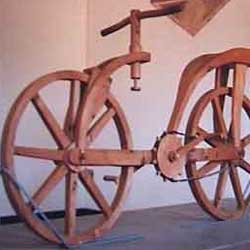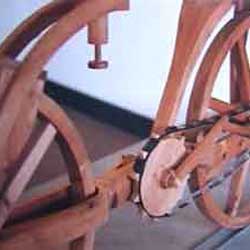|  Whoever drew that scribble, would you please stand up?
Whoever drew that scribble, would you please stand up?
After the restoration of one of Leonardo da Vinci's notebooks, a scribble
of a two-wheeler was found in the renaissance genius' manuscripts. It
was thought to be the drawing of the first bicycle. Later historians suspected
it was a monk's XX century fake.
Leonardo did not scribble that sketch, nor would he never have drawn
anything like that. Why? Because Leonardo was an architect, engineer,
inventor and painter. He dedicated his entire life to science and the
"belle arti" and simply did not draw like that.
So what is a scribble of a bicycle doing in the Atlanticus Codex - one
of Leonardo da Vinci's notebooks? This riddle has been puzzling historians
from all over the world since the1970s. Thirty years later we are no closer
to discovering who is the architect of the sketch - no solution has materialised
from all the critiques and accusations, only hypotheses.
"If there is a genius that is really misunderstood, this is Leonardo
da Vinci," says Sergio Milanesi, an Italian technical designer who
copies Leonardo's drawing for publications. "But Leonardo has his
faults too," adds Milanesi. "He did everything to be misunderstood
- reverse hand-writing, using pencils with dissolving colours, and never
tiding up his notes."
Leonardo wrote everywhere. Any piece of paper was good for him to note
down a thought or draw an idea. He had no formal training in Latin and
was considered illiterate in his day. His scrawled notes were almost incomprehensible.
According to legend, the Italian genius Leonardo da Vinci died while
pleading, "Tell me if any of my machines have been built." Critics
say that Leonardo never completed his projects, and when he did, they
didn't work. He foresaw many things that only recently have come into
use. His drawings were more prophetic dreams than engineer's blueprints
- take for example his helicopter, his tank or submarine, both of which
lack a workable mechanism for powering the invention. But it is the idea
that counts.
At the end of the XVI century an Italian sculptor and collector, Pompeo
Leoni, catalogued thousands of Leonardo's single manuscripts into notebook
form. The drawings of impenetrable fortresses, bizarre weapons and powerful
cannons made good buys for Lords who could study and put into practice
Leonardo's ideas.
Recently Bill Gates bought the Leonardo's Hammer Codex - ideas for new
software?
Since then the notebooks have been exported, lost, stolen, smuggled,
forgotten in old libraries, nibbled by rats and damaged by inexperienced
restorers. Today only 30 of Leonardo's 46 (circa) notebooks are held in
libraries. Some have been found by chance. Some are lost forever.
In the 1960s the "Ente Raccolta Vinciana", the Italian association
which collects studies of Leonardo's work from scholars world-wide, decided
to restore the Atlanticus Codex of Leonardo which is in the Ambrosiana
Library in Milan.
The library belonged to the Vatican and so did the codex. The Pope of
the time, Paul VI, consented to the restoration under the condition that
it was performed by the monks of the "Laboratorio di Restauro"
of the Abbey of Grottaferrata near Rome.
For security reasons a binding contract between the library and the restoration
laboratory stipulated that absolutely no person was to be admitted to
see the folios of the Codex during the restoration. This strict clause
was always rigorously observed.
Of the 1750 original sheets, cut, glued and reduced to 401 by Pompeo
Leoni, the monks resurrected more than 800 pages and rebuilt a new Atlanticus
Codex to 1286 folios. They reported that the manuscripts had been restored
by different hands at different times but not by them. They simply unglued,
washed (in a 4:1 part mix of water and alcohol) and rebound the precious
and delicate 400-year-old sheets of paper.
The notebook was then transferred to the Ambrosiana Library under police
escort, where it was photographed by the Italian publisher Giunti. And
it was on those photos that a connoisseur of Leonardo's thought and a
specialist in his idiosyncratic Latin, Augusto Marinoni, based his transcriptions.
The sketch of the first "bicycle" was in the photograph numbered
folio 133v. Marinoni dated this sketch circa 1493, the same date as that
written by Leonardo on the front page of Codex Madrid I, where on folio
10r there were chains with cubic teeth. The same insignia can be seen
on the bike. It was certain that it was not drawn by Leonardo, but probably
by pupils of Leonardo's "bottega" (= workshop).
Here began the arguments.
 There
is no trace of the original sketch of the first bicycle designed by Leonardo.
What we have is a bad reproduction - a child-like drawing - made in brown
crayon of a medieval non-steerable pedal-cycle on the reverse side of
a drawing fortress which certainly was drawn by Leonardo. There
is no trace of the original sketch of the first bicycle designed by Leonardo.
What we have is a bad reproduction - a child-like drawing - made in brown
crayon of a medieval non-steerable pedal-cycle on the reverse side of
a drawing fortress which certainly was drawn by Leonardo.
The drawing was hidden by collector Leoni because of the crude doodles
of a walking penis with a tail, a hairy anus and a keyhole vagina on the
same page.
Marinoni tried to convince other scholars that this was the work of one
of Leonardo's pupils who tried to copy a sketch that he had seen in the
studio. Next to the bike was a cruel caricature of a young boy. Only one
word appears on the sheet - Salai, meaning devil, which was the nickname
of Giacomo Caprotti. He was one of Leonardo's most favoured pupils, and
perhaps toyboy, who later became a famous painter.
However it's unlikely that a young boy of the XV century could have invented
a pedal-cycle 300 years before the official debut of the first two-wheeler,
the German "Running Machine".
But Leonardo could. "It's not the bicycle but its idea that was
born in Leonardo's mind," clarified Marinoni. The wheel already existed
and there is no doubt of the authenticity of the chains and teethed cogs
designed by Leonardo.
So what is the controversy? This theory has been repeatedly criticised,
but none of the Leonardo's historians have ever been able to give an alternative
explanation of the origin of that peurile sketch. Marinoni published several
books on the subject and until today his hypothesis has remained the most
reasonable.
In 1986 a full-scale wooden replica of the two-wheeler (see picture)
was built by Giovanni Sacchi, an Italian technical designer. And since
then it has been shown at the Museo Leonardiano di Vinci (near Florence)
as one of Leonardo's works.
In October 1997 when Marinoni was seriously ill, Prof. Hans Erhard Lessing
- a retired curator of the Museum of Technology and Labor of Mannheim
- published his theory of forgery in The Boneshaker and The New Scientist
which undermined Marinoni's hypothesis.
Lessing's theory is based on his scepticism and mistrust of the Italians.
"Without proven contemporaneity of the scribbles," says Lessing,
"Marinoni's tale of a pupil copying the bicycle from a lost drawing
of his master remains mere speculation."
Marinoni died on the 31st December 1997 and never had the chance to reply
to Lessing.
"Carlo Pedretti [an art historian of the University of California
at Los Angeles] told me that when in 1961 he first saw the original 133v,
he exposed the sheets to a very strong light because he was attracted
by some drawings visible through the paper. Actually, all he could see
were two circles and not what 13 years later Marinoni published in The
Unknown Leonardo as the drawing of the first bicycle ever conceived in
the history."
And when asked why Pedretti remembers this experience only 35 years later,
Lessing explains: "I started to doubt Marinoni's theory but I couldn't
find another one since nobody could have access to the original drawings.
Marinoni's fame was so established among the historians of Leonardo that
was unthinkable that he might be wrong. I tried very hard to express my
doubt about Leonardo's bike, but at that time was very hard to object
to Marinoni's thesis and the process of the monks' restoration.
Since 1968 when the Ambrosiana Library denied Pedretti the permission
to work on the original manuscript of the Codex Atlanticus, he has not
given too much importance to that sketch.
After several refusals of the Ambrosiana Library to open official inquires,
Lessing comments: "I'm more and more convinced of the forgery of
the sketch because of this "omertá" - mafia word for
silence - of the Ambrosiana's management. They do not want to fulfil my
requests, nor supply proof of the antiquity of the sketch. I think if
they had some positive results of carbon-date analysis that places the
sketch to 500 years ago, they would broadcast it."
The monks of the Laboratory of the Abbey of Grottaferrata maintain that
chemical analysis of the drawing may damage the antique manuscripts. It
may also be unsuccessful because of the existence of several means to
falsify antiques manuscripts.
Alessandro Vezzosi - currently the foremost authority on Leonardo in
Italy and also director of the Museo Ideale of Vinci - is sure of the
forgery - "To me the Ambrosiana's silence is a symptom of embarrassment
of having been had for more than 25 years".
Vezzosi will try to find a solution to this enigma on a trial web site
where everybody - scholars included - is free to support their theories
on the authenticity of the drawing.
"Because that drawing can not be attributed to Leonardo's hand,"
suggests Vezzosi, "and I'm sure of the honesty of the monks and of
Marinoni's professionalism, an alternative theory is that it might have
been drawn when the codices were in France - 1797-1815 - under Napoleon's
orders, and when similar bicycles were actually around."
But Marinoni has always maintained that it was spurious that someone
would orchestrate such a prank - re-glue Leonardo's sheets and wait for
the monks' restoration, almost two centuries later. What for? And why
not publicise their "discovery" then?
"The importance given here to the 'bicycle question' derives only
from the groundless attacks of Professor Hans Erhard Lessing," comments
Rosa Marinoni, wife of the historian. "He declares that the bicycle
was invented by his compatriot, the Baron Drais von Sonnerbronn, in 1897
(a fact that no one disputes).
"The press has surely misconstrued Lessing's words. I'm sure he
never directly accused the monks or my husband of forgery. These absurd
fantasies need no comment; a serious scholar bases his assertions on real
evidence and tries, at least, to be coherent and consistent with himself.
These assertions are pure nonsense. They seriously offend the Laboratorio
di Restauro of Grottaferrata, the Biblioteca Ambrosiana of Milan, and,
in particular, the memory of my husband."
"What for? Fame? Money? An article in a special magazine or an interview
in a national paper? And maybe a book that collects all the half-truths
and suppositions that have taken from Da Vinci the honour of having been
the inventor of such an ingenious machine."
Simple speculations will not solve the riddle unless whoever has drawn
that sketch - dead or alive - shows up. But surely the refusal of the
Ambrosiana's director, Monsignor Gianfranco Ravasi, to answer simple and
harmless questions does not help.
|